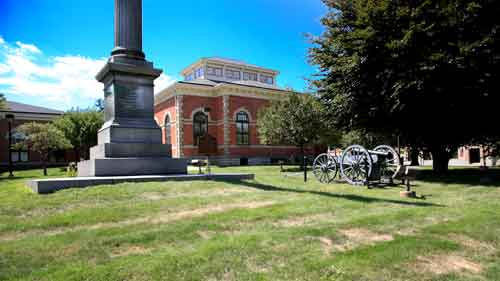Soldier's Monument
Fremont, Ohio: In 1881 citizens of of Fremont decided they wanted to erect a monument to the memory of the heroic dead soldiers of Sandusky County. On the committee appointed to undertake the task was a number of notable Sandusky County citizens including President Rutherford B. Hayes.

The selected site was the center of where the Battle of Fort Stephenson took place. The city had purchased the land just a few years before, grading it and building a stone wall around the square. The committee advertised for a design of the monument. New England Granite Works of Hartford Connecticut won the contract. At the time the monument cost about $7,000. It is made of Quincy granite except for the statue at the top which is made of Westerly Rhode Island granite. The entire structure is 44' 3" high. The Corinthian column is 3' in diameter at the bottom and 2' 6" in diameter at the top. The soldier's statue is 8' including the base.

The base has the following inscriptions:
North:
TO HIM WHO HATH
BORNE THE BATTLE
AND TO HIS WIDOW AND HIS ORPHANS.
ERECTED BY THE PEOPLE OF
SANDUSKY COUNTY, 1885
East:
LIBERTY AND UNION NOW AND FOREVER,
ONE AND INSEPARABLE.
1861 - 1865
South:
IN MEMORY OF THE
VICTORIOUS DEFENCE OF FORT STEPHENSON,
ON THIS SPOT,
BY MAJOR GEORGE CROGHAN AND THE
BRAVE MEN OF HIS COMMAN,
AUGUST 2, 1813
West (taken from a badge created by the Grand Army of the Republic):
Vacant places at our camp fires,
Mutely tell of comrades dead,
Fallen in the line of duty,
Where the needs of battle led.
Old Betsy
Old Betsy, the single 6 pound cannon that played such a critical role in the Battle of Fort Stephenson is now part of the Soldier's Monument in Fort Stephenson Park. After the War of 1812, the cannon was sent to the government arsenal in Pittsburg where it remained for a number of years. Then in 1852, Brice Bartlett, a prominent lawyer and Mayor of Lower Sandusky (now Fremont), thought it would be good if the town could retrieve the old cannon from storage. A local man who had not only served at Fort Stephenson, but also helped man the gun, told Mayor Bartlett that he could positively identify the cannon because of a peculiar marking on the weapon.
The veteran then went to Pittsburg to identify it. Once identified and through Bartlett's persistence, he was able to get the weapon shipped to Lower Sandusky. However, there were several communities named Sandusky (Upper Sandusky, Lower Sandusky, Sandusky). When shipped, the weapon ended up in Sandusky (on Lake Erie's shore). When officials of Sandusky received the unexpected shipment from the government arsenal, they decided to keep it. After Mayor Bartlett contacted the arsenal about the missing shipment, it became apparent to him where the weapon had gone. He demanded it be turned over, but rather than admit the mistake, the folks in Sandusky buried the gun. Not to be deterred, Bartlett hired a detective to find the gun and retrieve it.
After some searching, the detective reported back the exact location of the weapon. Several people including the Major hired a team and several men to go to Sandusky and in the stillness of night uncover the old cannon and return it to Fremont. On August 2, 1852, a celebration of Croghan's victory was held and Old Betsy was unveiled in its current location.





